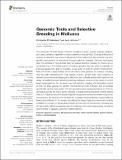Files in this item
Genomic tools and selective breeding in molluscs
Item metadata
| dc.contributor.author | Hollenbeck, Christopher M. | |
| dc.contributor.author | Johnston, Ian A. | |
| dc.date.accessioned | 2018-07-23T10:30:13Z | |
| dc.date.available | 2018-07-23T10:30:13Z | |
| dc.date.issued | 2018-07-18 | |
| dc.identifier | 255029781 | |
| dc.identifier | 2febfa1a-ac13-444f-8c24-5994a79307f3 | |
| dc.identifier | 85050238465 | |
| dc.identifier | 000439089900001 | |
| dc.identifier.citation | Hollenbeck , C M & Johnston , I A 2018 , ' Genomic tools and selective breeding in molluscs ' , Frontiers in Genetics , vol. 9 , 253 . https://doi.org/10.3389/fgene.2018.00253 | en |
| dc.identifier.issn | 1664-8021 | |
| dc.identifier.other | RIS: urn:3049BC1BD84BC3A07CF3A9371594E3FD | |
| dc.identifier.uri | https://hdl.handle.net/10023/15638 | |
| dc.description | This review of genetic resources and selective breeding in molluscs was carried out as part of the European Marine Biological Research Infrastructure Cluster (EMBRIC) project funded by the European Union's Horizon 2020 research and innovation program under grant agreement No 654008. | en |
| dc.description.abstract | The production of most farmed molluscs, including mussels, oysters, scallops, abalone, and clams, is heavily dependent on natural seed from the plankton. Closing the lifecycle of species in hatcheries can secure independence from wild stocks and enables long-term genetic improvement of broodstock through selective breeding. Genomic techniques have the potential to revolutionize hatchery-based selective breeding by improving our understanding of the characteristics of mollusc genetics that can pose a challenge for intensive aquaculture and by providing a new suite of tools for genetic improvement. Here we review characteristics of the life history and genetics of molluscs including high fecundity, self-fertilization, high genetic diversity, genetic load, high incidence of deleterious mutations and segregation distortion and critically assess their impact on the design and effectiveness of selective breeding strategies. A survey of the results of current breeding programs in the literature show that selective breeding with inbreeding control is likely the best strategy for genetic improvement of most molluscs, and on average growth rate can be improved by 10% per generation and disease resistance by 15% per generation across the major farmed species by implementing individual or family-based selection. Rapid advances in sequencing technology have resulted in a wealth of genomic resources for key species with the potential to greatly improve hatchery-based selective breeding of molluscs. In this review, we catalogue the range of genomic resources currently available for molluscs of aquaculture interest and discuss the bottlenecks, including lack of high-quality reference genomes and the relatively high cost of genotyping, as well as opportunities for applying genomics-based selection. | |
| dc.format.extent | 15 | |
| dc.format.extent | 1143155 | |
| dc.language.iso | eng | |
| dc.relation.ispartof | Frontiers in Genetics | en |
| dc.subject | Aquaculture | en |
| dc.subject | Genomics | en |
| dc.subject | SNP genotyping | en |
| dc.subject | Heritability | en |
| dc.subject | Marker assisted selection | en |
| dc.subject | Genomic selection | en |
| dc.subject | Molluscs | en |
| dc.subject | Selective breeding | en |
| dc.subject | SH Aquaculture. Fisheries. Angling | en |
| dc.subject | QH301 Biology | en |
| dc.subject.lcc | SH | en |
| dc.subject.lcc | QH301 | en |
| dc.title | Genomic tools and selective breeding in molluscs | en |
| dc.type | Journal item | en |
| dc.contributor.sponsor | European Commission | en |
| dc.contributor.institution | University of St Andrews. School of Biology | en |
| dc.contributor.institution | University of St Andrews. Marine Alliance for Science & Technology Scotland | en |
| dc.contributor.institution | University of St Andrews. Scottish Oceans Institute | en |
| dc.contributor.institution | University of St Andrews. Centre for Research into Ecological & Environmental Modelling | en |
| dc.identifier.doi | 10.3389/fgene.2018.00253 | |
| dc.description.status | Peer reviewed | en |
| dc.identifier.grantnumber | 654008 | en |
This item appears in the following Collection(s)
Items in the St Andrews Research Repository are protected by copyright, with all rights reserved, unless otherwise indicated.

